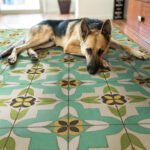Annie Sloan, whose paint company has become a global success story since launching in the U.K. in 1990, recently opened its first ever flagship store — not in Britain, but in downtown Toronto, Canada. I wrote about new retail space for Chalk Paint by Annie Sloan for the Toronto SUN.
In town for the opening, Sloan also explained the fascinating backstory of the three colours that form the new Charleston collection — Rodmell, Tilton and Firle.

The palette was drawn from the famous Charleston Farmhouse, a gathering spot for the Bloomsbury Group, the legendary salon that the painter (and sister of Virginia Woolf) Vanessa Bell started in 1905. Interestingly, despite being a talented painter, Bell has never been as well known as some of the male members: writer and critic Lytton Strachey, her husband/art critic Clive Bell, publisher Leonard Woolf, economist John Maynard Keynes, writer/publisher David Garnett, and artist Duncan Grant. (Hello, #sexisthistory!) Later, the group embraced Europe’s leading avant-garde artists, including Pablo Picasso, Jean Cocteau and Eric Satie.
According to the Tate Museum, Bell formed the club while at University as a way to give artists and writers a place to talk about their work and ideas, discuss what was happening in the art world, and organize exhibitions.
Despite coming from privilege, members of this eclectic group — full of outsized, colourful personalities — were seen as vanguards. They rebelled against what they saw as the stifling conventions of their parents’ generation, whether they pertained to art, politics, or sexual orientation and gender stereotypes. Their thoroughly modern approach to the latter resulted in a tangled web of complicated romantic relationships and sexual liaisons which, if you like good literary gossip, is a fun read.


It was Bell, who with husband Clive, owned Charleston Farmhouse, which The Tate describes as rather run-down, with an overgrown garden and no electricity, telephone, or central heating.
What it did have was a beautifully bucolic setting, and walls, fireplaces, door panels, and furniture all wonderfully decorated in Bell’s distinctive painting style. Sloan says she’s always been drawn to the casual, cozy, friendly feel of Bell’s work, and that she’s been visiting the site since she was an art student in the 1970s.
“It’s very ‘doodlely’ with lots of spots and dots,” she says. “It’s more about mark-making than painting, and it’s very approachable. You look at things and think, ‘oh, I could do that’. I love that.”
Fabrics and ceramics were designed by Bloomsbury member Roger Fry, who owned a design collective called Omega Workshops.
The Cambridge Guide to Literature in English suggests that while the members denied that they were a formal group, the recognition of art as essential to life was a shared foundational belief. Charleston Farmhouse was a living canvas, an ode to that notion.

Sloan suggests that replicating this informal – yet rich and layered – look is easy with her Chalk Paints — a water-based, non-toxic formula that can be applied to most surfaces, and typically requires no priming or sanding. It can be used on walls, floors, wood, concrete, metal, matte plastic, earthenware, brick, stone, and more – inside or outside — as well as on upholstery and to dye fabric.
Fans speak of the freshness and vibrancy of the palette — a result, says Sloan, of there being no black in the formulation. “So when you mix two colours, they are more lively and interesting,” she explains, ““especially when you add whites.”
HOT TIP: If you make it down to the store, keep an eye out for works by decorative painter Jim Connelly, and Jelena Pticek, Annie Sloan’s first Canadian painter in residence and the owner of Poppyseed Creative Living which also stocks Chalk Paint. And do check out the work of furniture artist Ildiko Horvath – who’s a long time user of the paint, and has a special gift with colour. All of them do such lovely work. Treat yourself to a peek.
PS: The store also carries the full line of Annie Sloan fabrics. I’m a fan. Learn more here.
Featured pic shows Firle (on the walls) and Rodmell on the chair.




